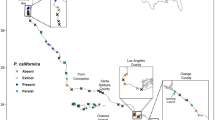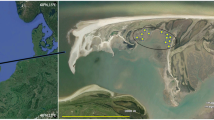Abstract
From a series of 10 quarterly assessment between October 1975 and May 1978 (inclusive), fluctuations in abundance were determined for macroinvertebrates and macrophytes of a rocky intertidal community on Santa Cruz Island, California, USA. During afternoon low tides in late fall and winter of the first 2 yr of study, organisms of the upper and middle intertidal zones were subjected to prolonged aerial exposure. Many species there tolerated this exposure, but die-backs occurred for a barnacle (Chthamalus fissus/C. dalli) and several algae (Endocladia muricata, Pelvetia fastigiata f. gracilis, Corallina officinalis var. chilensis, Corallina vancouveriensis, Cylindrocarpus rugosus and Codium fragile). These die-backs were succeeded by blooms of Ulva californica and Porphyra perforata. In the upper and middle intertidal zones, the major cover organisms that could tolerate prolonged aerial exposure were disproportionately prevalent and appeared to be maintained by the periodic repression of species intolerant to such exposure. In February 1978, heavy rainfall caused sediment inundation of the middle and lower intertidal zones. This event was followed by declines in abundance of a barnacle (Tetraclita rubescens) and several algae (Pelvetia fastigiata f. gracilis and corallina spp.). Shannon-Wiener H′ species diversity fluctuated from a high in October to a low the following May during both 1975–1976 and 1976–1977 in conjunction with the period of increased daytime aerial exposure in late fall and winter. A further decline in diversity following sediment inundation in February 1978 contributed to a long-term trend of declining H′ species diversity (3.06 in October 1975 to 1.87 in May 1978). We hypothesize that predictable late fall to winter aerial exposure stresses, in combination with a random physical disturbance (sediment burial), exceeded an “optimal” intermediate level of disturbance predicted for maximal species diversity.
Similar content being viewed by others

Literature Cited
Bayne, B. L., C. J. Bayne, T. C. Carefoot and R. J. Thompson: The physiological ecology of Mytilus californianus Conrad. 2. Adaptations to low oxygen tension and air exposure. Oecologia 22, 229–250 (1976)
Brumbaugh, R. W.: Recent geomorphic and vegetal dynamics of Santa Cruz Island. In: the California Islands: proceedings of a multidisciplinary symposium, pp 139–158. Ed. by D. M. Power. Santa Barbara: Santa Barbara Museum of Natural History 1980
Castenholz, R. W.: Stability and stresses in intertidal populations. In: Pollution and marine ecology. pp 15–28. Ed. by T. A. Olson and F. J. Burgess. New York: Wiley 1967
Connell, J. H.: Diversity in tropical rain forests and coral reefs. Science, N.Y. 199, 1302–1310 (1978)
Dayton, P. K.: Competition, disturbance and community organization: the provision and subsequent utilization of space in a rocky intertidal community. Ecol. Monogr. 41, 351–389 (1971)
Edwards, P.: An investigation of the vertical distribution of selected benthic marine algae with a tide-simulating apparatus. J. Phycol. 13, 62–68 (1977)
Emerson, S. E. and J. B. Zedler: Recolonization of intertidal algae: an experimental study. Mar. Biol. 44, 315–324 (1978)
Fisher, R. V. and D. W. Carlton: Mid-Miocene Blanca Formation, Santa Cruz Island, California. In: Aspects of the geological history of the California continental borderland, pp 228–240. Ed. by D. G. Howell, Menlo Park: American Association of Petroleum Geologists 1976. (Misc. Publ. Am. Ass. Petrol. Geol., Pacif. Sect. No. 24)
Foster, B. A.: Tolerance of high temperatures by some intertidal barnacles. Mar. Biol. 4, 326–332 (1969)
Foster, B. A.: Desiccation as a factor in the intertidal zonation of barnacles. Mar. Biol. 8, 12–29 (1971)
Fox, J. F.: Intermediate-disturbance hypothesis. Science, N.Y. 204, 1344–1345 (1979)
Grime, J. P.: Evidence for the existence of three primary strategies in plants and its relevence to ecological and evolutionary theory. Am. Nat. 111, 1169–1194 (1977)
Gunnill, F. C.: Recruitment and standing stocks in populations of one green and five brown algae in the intertidal zone near La Jolla, California during 1973–1977. Mar. Ecol. Prog. Ser. 3, 231–243 (1980a)
Gunnill, F. C.: Demography of the intertidal brown alga Pelvetia fastigiata in Southern California, USA. Mar. Biol. 59, 169–179 (1980b)
Harger, J. R. E. and D. L. Landenberger: The effect of storms as a density dependent mortality factor on populations of sea mussels. Veliger 14, 195–201 (1971)
Hart, C. E. and J. H. Crowe: The effect of attached gravel on survival of intertidal anemones. Trans. Am. microsc. Soc. 96, 28–41 (1977)
Hay, M. E.: Functional morphology of turf-forming seaweeds: persistence in stressful marine habitats. Ecology 62, 739–750 (1981)
Hewatt, W. G.: Marine ecological studies on Santa Cruz Island, California. Ecol. Monogr. 16, 186–208 (1946)
Hines, A. H.: Reproduction in three species of intertidal barnacles from central California. Biol. Bull. mar. biol. Lab., Woods Hole 154, 262–281 (1978)
Levin, S. A. and R. T. Paine: Disturbance, patch formation and community structure. Proc. natn. Acad. Sci. U.S.A. 71, 2744–2747 (1974)
Littler, M. M.: Overview of the rocky intertidal systems of southern California. In: The California Islands: proceedings of a multidisciplinary symposium, pp 265–306. Ed. by D. M. Power. Santa Barbara: Santa Barbara Museum of Natural History 1980a
Littler, M. M.: Morphological form and photosynthetic performance of marine macroalgae: tests of a functional form hypothesis. Botanica mar. 22, 161–165 (1980b)
Littler, M. M.: Southern California rocky intertidal ecosystems: methods, community structure and variability. In: The shore environment, Vol. 2: Ecosystems, pp 565–608. Ed. by J. H. Price, D. E. G. Irvine and W. F. Farnham. New York: Academic Press 1980c. (Systematics Association Special Volume No. 17b)
Littler, M. M. and S. N. Murray: Impact of sewage on the distribution, abundance and community structure of rocky intertidal macro-organisms. Mar. Biol. 30, 277–291 (1975)
Murray, S. N. and M. M. Littler: Patterns of algal succession in a perturbated marine intertidal community. J. Phycol. 14, 506–512 (1978)
Osman, R. W.: The establishment and development of a marine epifaunal community. Ecol. Monogr. 47, 37–63 (1977)
Paine, R. T.: Food web complexity and species diversity. Am. Nat. 100, 65–75 (1966)
Ricketts, E. F., J. Calvin and J. W. Hedgpeth: Between Pacific tides, 614 pp Stanford: Stanford University Press 1968
Schick, J. M., W. I. Brown, E. G. Dolliver and S. R. Kayar: Oxygen uptake in sea anemones: effects of expansion, contraction, and exposure to air and the limitations of diffusion. Physiol. Zoöl. 52, 50–62 (1979)
Schonbeck, M. and T. A. Norton: Factors controlling the upper limits of fucoid algae on the shore. J. exp. mar. Biol. Ecol. 31, 303–313 (1978)
Seapy, R. R. and W. J. Hoppe: Morphological and behavioral adaptations to desiccation in the intertidal limpet Acmaea (Collisella) strigatella. Veliger 16 181–188 (1973)
Seapy, R. R. and M. M. Littler: Biological features of rocky intertidal communities near Willows Anchorage, Santa Cruz Island, California. In: Spatial and temporal variations in the distribution and abundance of rocky intertidal and tidepool biotas in the Southern California Bight, pp 685–794. Ed. by M. M. Littler. Washington D.C.: Department of the Interior, Bureau of Land Management 1977
Seapy, R. R. and M. M. Littler: The distribution, community structure, and primary productivity of macroorganisms from two central California rocky intertidal habitats. Pacif. Sci. 32, 293–314 (1978a)
Seapy, R. R. and M. M. Littler: Variations in the rocky intertidal biota near Willows Anchorage, Santa Cruz Island, California. In: The annual and seasonal ecology of southern California rocky intertidal, subtidal, and tide pool biotas in the Southern California Bight, Chapter 1.1.9. pp 1–64. Ed. by M. M. Littler. Washington D.C.: Department of the Interior, Bureau of Land Management 1978b
Seapy, R. R. and M. M. Littler: Assessments of the distribution, abundance and community structure of rocky intertidal organisms at Willows Anchorage, Santa Cruz Island, California. In: The distribution, abundance and community structure of rocky intertidal and tidepool biotas in the Southern California Bight, Chapter 1.11. pp 1–41. Ed. by M. M. Littler. Washington D.C.: Department of the Interior, Bureau of Land Management 1979a
Seapy, R. R. and M. M. Littler: The impact of heavy sediment loading on the rocky intertidal biota at Willows Anchorage, Santa Cruz Island, California. In: Catastrophic surveys of rocky intertidal communities following natural disturbances. Chapter 3.4, pp 1–35. Ed. by M. M. Littler Washington, D.C.: Department of the Interior, Bureau of Land Management 1979b
Seapy, R. R. and M. M. Littler: Biogeography of rocky intertidal macroinvertebrates. In: The California Islands: proceedings of a multi-disciplinary symposium, pp 307–323. Ed. by D. M. Power. Santa Barbara: Santa Barbara Museum of Natural History 1980
Shannon, C. E. and W. Weaver: The mathematical theory of communication, 111 pp. Urbana: University of Illinois Press 1963
Shepherd, S. A.: Ecological strategies in a deep water red algal community. Botanica mar. 24, 457–463 (1981)
Sokal, R. R. and P. H. A. Sneath: Principles of numerical taxonomy, 359 pp. San Francisco: W. H. Freeman & Co. 1963
Sousa, W. P.: Disturbance in marine intertidal boulder fields: the nonequilibrium maintenance of species diversity. Ecology 60, 1225–1239 (1979)
Stephenson, W. A. and A. Stephenson: Life between tidemarks on rocky shores, 425 pp. San Francisco: W. H. Freeman & Co. 1972
Vermeij, G. J.: Biogeography and adaptation: patterns of marine life, 332 pp. Cambridge: Harvard University Press 1978
Author information
Authors and Affiliations
Additional information
Communicated by N. D. Holland, La Jolla
Rights and permissions
About this article
Cite this article
Seapy, R.R., Littler, M.M. Population and species diversity fluctuations in a rocky intertidal community relative to severe aerial exposure and sediment burial. Mar. Biol. 71, 87–96 (1982). https://doi.org/10.1007/BF00396995
Accepted:
Issue Date:
DOI: https://doi.org/10.1007/BF00396995



